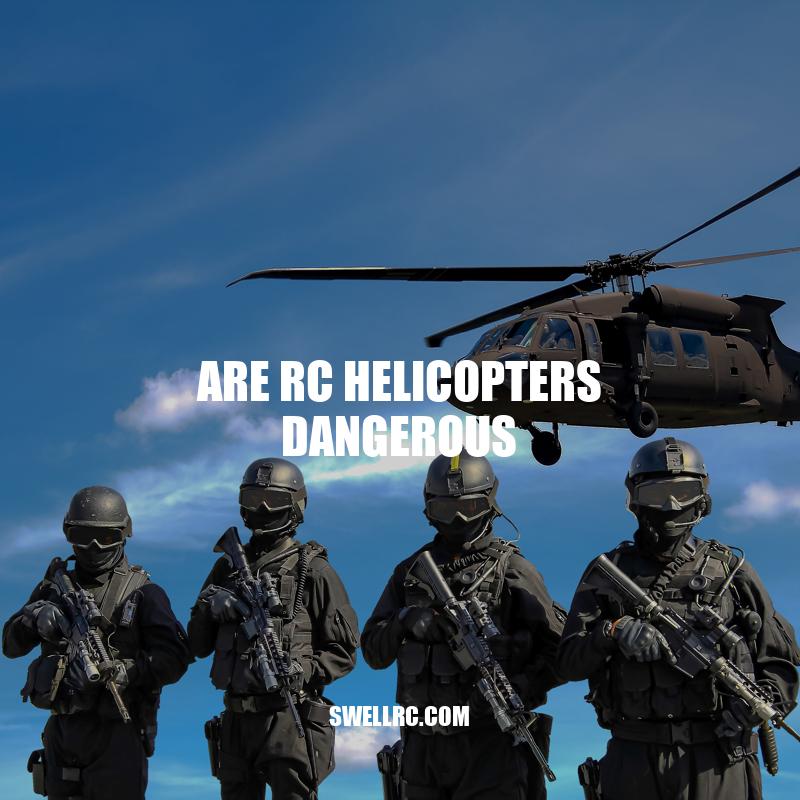Are RC Helicopters Safe? A Guide to Understanding Potential Dangers and Essential Safety Precautions
RC helicopters are a hobby that is becoming increasingly popular among adults and children alike. These miniature flying devices offer an exciting and relatively affordable way to experience the thrill of aviation. However, as with any other activity that involves flying, there can be risks involved. For this reason, questions concerning the safety of RC helicopters are frequently asked. Are RC helicopters dangerous? This is a valid question that deserves a thoughtful and comprehensive answer. While there are potential hazards associated with this activity, there are steps individuals can take to mitigate these risks and enjoy their hobby safely. This article will examine the concerns regarding the safety of RC helicopters and provide practical advice for how to engage in this hobby without putting oneself or others in danger.
Understanding the Risks
Flying an RC helicopter can be a fun and exciting experience but there are risks that individuals need to be aware of before attempting to fly. Understanding these risks is crucial for ensuring the safety of oneself and others.
Some of the risks associated with RC helicopters include:
- Collision with people, animals or other objects such as buildings, trees or vehicles
- Crashing due to equipment failure or weather conditions
- Loss of control of the aircraft
- High altitude or uncontrolled descent that can lead to damage or injury
It is important to note that while these risks exist, they can be significantly reduced or even avoided entirely by taking proper precautions and measures. Reading the instruction manual and familiarizing oneself with the device is a necessary first step to understanding the risks involved. Additionally, individuals should always be aware of their surroundings and take caution to fly in a safe location.
How risky is a helicopter?
Helicopters are generally considered safe, but there are risks associated with flying in any aircraft. According to the National Transportation Safety Board, the accident rate for helicopters is higher than for fixed-wing aircraft. However, the vast majority of helicopter flights are completed without incident.
Factors that can increase the risk of a helicopter accident include:
- Weather conditions
- Pilot error
- Mechanical failure
- Low-altitude operations
- Night operations
- Flight over water or remote areas
It’s important to note that many helicopter accidents are preventable with proper maintenance, training, and adherence to best practices for safe helicopter operations.
If you’re interested in learning more about helicopter safety, the Federal Aviation Administration offers resources, including the Helicopter Flying Handbook and Helicopter Instructor’s Handbook, available on their website.
Essential Safety Precautions
To reduce the risk of accidents or injury when flying an RC helicopter, certain safety precautions need to be taken. Here are some essential measures that should be implemented:
Safety Gear
RC helicopters can cause serious injuries, especially to the eyes, so it is important to wear appropriate safety gear. Here are some examples:
- Goggles: Prevent eye injury due to debris or propeller blades
- Helmets: Provide head protection in the event of a crash
- Gloves: Reduce the risk of injury to hands and fingers when working on the helicopter
Instruction Manual
The instruction manual is an important resource for understanding the operation of the RC helicopter. Individuals should read and follow all instructions closely to ensure safe use of the device.
Pre-Flight Checklist
Before flying the RC helicopter, individuals should follow a pre-flight checklist that includes inspecting the helicopter and surrounding area for potential hazards.
By implementing these essential safety precautions, individuals can enjoy the thrill of flying an RC helicopter while reducing the risk of accidents and injury.
What are safety precautions and why are they important?
- Safety precautions are measures taken to reduce the risk of injury, damage, or loss.
- They are important because they can prevent accidents and injuries, protect property, and save lives.
- Examples of safety precautions include wearing protective equipment, such as helmets and safety glasses, using safety equipment, such as guardrails and safety harnesses, following safety procedures and guidelines, and maintaining equipment and tools.
Flying in Safe Locations
Selecting a safe location to fly an RC helicopter is essential to ensure the safety of people and property. Here are some guidelines to flying in safe locations:
Avoid Crowded Areas
RC helicopters should not be operated in areas with high concentrations of people, animals or moving vehicles. To avoid crowding, choose an open area that allows for plenty of space around the helicopter.
Weather Conditions
Weather is another key factor when deciding where to fly an RC helicopter. The following guidelines should be followed when flying:
- Avoid flying in wet or windy weather to reduce the risk of crashes or damage to the helicopter.
- Choose a time and place to avoid direct sunlight, which can make it difficult to see and control the helicopter.
- Avoid flying during electrical storms, which can cause interference between the remote control and the helicopter.
Regulations on Flying
It is important to note that regulations regarding the use of RC helicopters can vary depending on the location. For instance, some areas may prohibit the use of RC helicopters due to noise pollution concerns or potential damage to the environment. Check with local authorities to confirm the legality of flying an RC helicopter in a given location.
By following these guidelines on selecting safe flying locations, RC helicopter enthusiasts can enjoy their hobby while also ensuring the well-being of others and the environment.
Can I fly RC helicopter anywhere?
Here are a few points to keep in mind when flying an RC helicopter:
- It is important to check with your local regulations and laws regarding where you can fly an RC helicopter.
- Some areas may have designated RC flying areas, while others may not allow it at all.
- Always follow safety guidelines and fly in an open area away from people and structures.
- Consider purchasing an RC helicopter with quiet motors if you plan to fly in residential areas.
- Check out websites such as AMA (Academy of Model Aeronautics) for more information and resources on RC flying.
Proper Handling and Skill Development
To safely operate an RC helicopter, it is important to be skilled and knowledgeable in handling it. Here are some tips for proper handling and skill development:
Practice in Open Spaces
It is recommended to practice flying an RC helicopter in an open space, away from obstructions or hazards like trees, poles, or buildings. This will help you build confidence and develop control over the helicopter.
Start Small
Start with a small and simple RC helicopter as it is easier to handle and control. Beginners should learn the basics of hovering and steering before attempting more complicated maneuvers.
Join RC Helicopter Communities
Joining a community of experienced RC helicopter enthusiasts is one of the best ways to learn more about proper handling and skill development. Here, you will have opportunities to learn from experts, observe how they operate their RC helicopters, and engage in helpful discussions.
Assistance of Skilled Pilots
Whenever possible, seek the assistance of skilled pilots to help you learn the basics of flying an RC helicopter. Experienced pilots can provide hands-on guidance and give you tips on how to effectively handle the helicopter.
By incorporating these tips into your practice, you can improve your skills and safely operate an RC helicopter with confidence.
How can I improve my skill development?
Here are some tips to improve your skill development:
- Identify your desired skill set and research the tools, resources and techniques to help achieve it.
- Take courses, workshops or online classes in areas of interest.
- Participate in networking events or online communities to connect with like-minded individuals and gain new insights or approaches.
- Set specific goals and measure progress to track and celebrate improvements.
- Read books, blogs or listen to podcasts that address your area of focus.
- Practice consistently and seek feedback from peers, mentors or coaches to refine your skills.
There are also websites and products available, such as LinkedIn Learning or Udemy, that offer a wide range of courses and resources for skill development.
Legal Regulations and Requirements
Before flying an RC helicopter, it is important to ensure that you are aware of the legal regulations and requirements in your area. Here are some important legal considerations to keep in mind:
Registration and Licensing
In some countries like the United States, the Federal Aviation Administration (FAA) requires that all RC aircrafts, including helicopters, weighing more than 0.55 pounds (or 250 grams) be registered. Additionally, some countries may require a license to operate RC helicopters.
Restricted Areas
There may be certain areas where flying RC helicopters is not permitted, such as near airports or military bases. You should check with your local authorities to find out about any restricted areas in your region.
Privacy Laws
When flying an RC helicopter with a camera, it’s important to note that there are privacy laws governing their use. Be sure to research any regulations concerning the use of cameras on RC helicopters.
Know Your Limits
It’s also important to remember your own limits and experience level. It’s wise to start slow and gradually increase the level of difficulty as you become more experienced.
By following these legal regulations and requirements, you can safely operate an RC helicopter without fear of violating any laws or regulations.
What are the regulatory requirements?
In order to ensure compliance with regulations and guidelines, it is important to be aware of the requirements that govern website(s) or product(s). Here are some important regulatory requirements to keep in mind:
- Ensure that all information presented is accurate and backed up by reliable sources
- Provide clear disclosures about the nature of the product or service being offered
- Comply with relevant laws and regulations governing the industry, such as HIPAA for healthcare products
- Follow ethical guidelines and best practices for online marketing and promoting products
Taking the time to understand and comply with these requirements can help establish trust with customers and avoid potential legal issues in the future.
Conclusion
In conclusion, RC helicopters are extremely fun, but safety should be a priority at all times. While there are some risks associated with operating an RC helicopter, they can be greatly minimized by following safety precautions and adhering to legal requirements.
If you’re just starting out with RC helicopters, be sure to read the instruction manual thoroughly and practice in a safe, open area. It’s also wise to invest in safety gear like goggles and helmets, and to gradually develop your skills over time.
Don’t be afraid to seek advice from more experienced pilots or join RC helicopter communities to gain knowledge and experience. Always remember to follow the legal regulations in place and know your limits.
RC helicopters offer an exciting and rewarding hobby for people of all ages. With proper knowledge and care, you can enjoy the thrill of flight while ensuring your safety and that of others around you.



